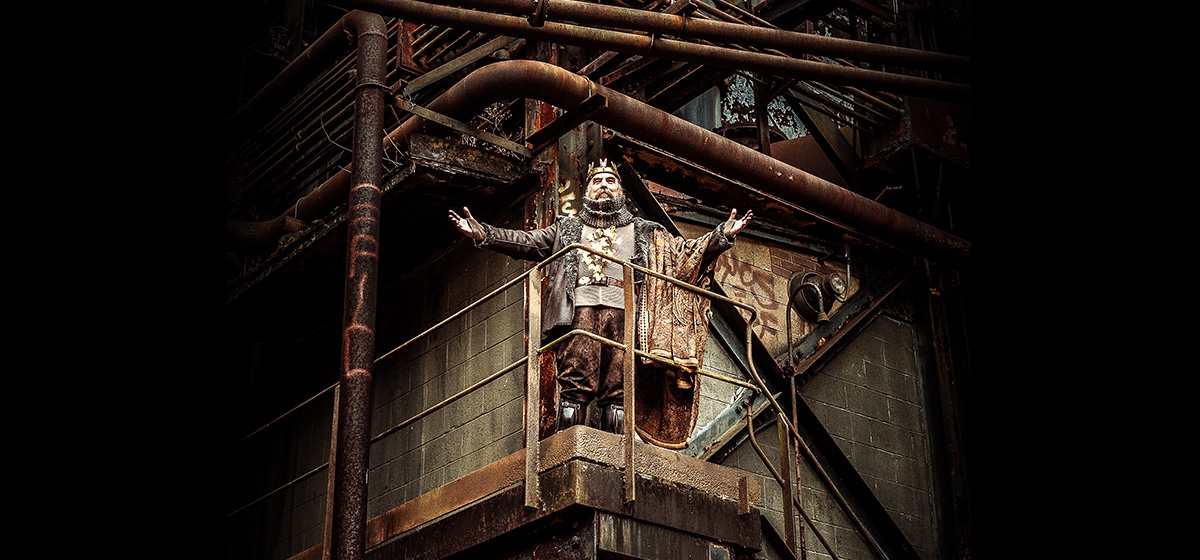Lear in the Furnace: A Review of Quantum Theatre’s “King Lear”

Attending a Quantum Theatre production can be like traveling to one of those crazy destination weddings where they make you climb up some precipitous volcano to reach the venue, while you ponder the wedding planner’s sanity. You know the view will be fantastic, but is the journey worth it? In the case of William Shakespeare’s “King Lear,” (1605) performed at two locations within the historic Carrie Blast Furnace site (and which requires a bit of trekking between them), the answer is absolutely yes.
Normally, a review would analyze the physical creation of the scenic designer, Tony Ferrieri, but in this case, what we see, except for a few theatrical embellishments, is almost totally organic: a 92-foot, century-plus-old steel-making facility. It’s like a decayed, steam punk version of “Jurassic Park” where everything is monstrously outsized, and it’s even more foreboding than the monumental processing plant-backdrop utilized in the climax of the film “Aliens.” Ferrieri’s judiciousness in not adding to that which requires no addition is testament to his acute vision as a design professional.
This is certainly the most dramatic production you will see this year, and probably this decade. The brilliance of the decision to use the Carrie site for “King Lear” is that it enables Quantum to achieve the kind of operatic intensity that so many theatrical efforts strive for, but never achieve, because “operatic” sets are usually so overblown and ersatz as to be laughable (e.g. the Metropolitan Opera’s recent Ring cycle production). This one is about as serious as, well, a 10-story blast furnace.
The other factor that sets this show apart is that the entire cast is strong. There are only 11 actors—with a couple playing double roles—and each brings intensity to every moment they are on stage, which is no easy task for Shakespeare, whose plays are often recited more than acted. The lines are spoken and reacted to the way human beings do when actually listening to each other, and if you see a lot of the Bard’s plays you know this is a rarity. No one is coasting on their English accents.
Director Risher Reddick does things with his actors like a New Wave auteur: he plays with space and time and perspective in ways that take advantage of this bewildering environment. For example, the cast all have wireless mics, so they can appear anywhere in the sprawling set and be heard instantly—whether on a soaring walkway or at ground level—and with the help of C. Todd Brown’s nimble lighting, be seen as well.
Brown is like a cinematographer using the technique of a focus puller to keep us following action that could easily get lost in the phantasmagoric jumble of steel pipes, bricks, and huge slabs of rusting metal. This allows the staging of a couple of characters speaking in the foreground, followed by a smash cut—signaled by lighting and movement—to a scene high and much further away than would be possible in any theater. And during the famous storm sequence, the lightning is generated from inside the furnace, which makes absolute sense, as it allows the audience to experience a kind of historic flashback (pun intended) to the setting they are occupying.
Woven into all of this are Steve Shapiro’s sound designs, which infuse the atmosphere organically. When a trumpet blast is called for, a steam whistle blows, just as it might have 75 years ago. And you really don’t know where nature begins and his technical machinations end. During the storm, for instance, his recorded wind, and the actual wind blowing through the air, coalesce, so the experience feels synergistic, not synthetic. This is another attribute of the play being performed entirely outside. If you are lucky enough to attend on a rainy night, you are in for a primal treat.
This ethos is employed by the entire technical crew—nothing is forced on the audience: the set, lighting and sound are like suggestions that the viewer’s mind completes. Such a less-is-more approach is as audacious as it is uncommon.
Jeffrey Carpenter (King Lear), overwhelms by underplaying. He’s not the bombastic monarch of stereotypical portrayals, but a man unabashedly confused by the universe just when he thinks he has it figured out. Carpenter has a plaintive, saxophone voice, and he’s strikingly reminiscent of the doomed Frank Pentangeli character from the second “Godfather” film, in both appearance and speech. He embraces the complex nature of Lear, evoking a soul in pain rummaging through a bin of emotions to cope with an existential crisis he never faced as king, but now must confront as a man. For example, he creates a stunning moment that simultaneously evokes pathos and humor with the line, “I will do such things,– / What they are yet I know not,–” that would be forced one way or the other by most actors.
After Lear, Edgar has the most lines in the play, and Connor McCanlus, who portrays him (as well as Cornwall), is brilliant at revealing the depth of this character, which really is a double role, as Edgar assumes the mad identity of “Tom of Bedlam” in the course of the action. McCanlus keeps pulling more and more out of himself as the play transpires, like a magician fishing handkerchiefs out of his pocket. The role of Edgar was so important to Shakespeare that it’s actually cited on the title page of the First Quarto of “King Lear” in 1608, yet it’s one of the most misunderstood and misplayed parts in the playwright’s oeuvre. McCanlus’s interpretation is inspired and innovative.
Tami Dixon as The Fool (and three additional characters) is the third leg this production stands on. Her Fool thinks it’s her play, and this is as it should be. She projects an insouciant knowingness which plays to Lear’s cognitive impotence. They’re like an old couple that not only understand but depend on each other’s susceptibilities. Dixon’s chanting and harmonica playing lend the comically wise authority necessary to goad Lear to the madness essential for the play’s success.
Ken Bolden’s interpretation of Gloucester is deeply considered and moving. He gives his character’s words appropriate gestation, so that his sufferings—culminating in his awful blinding—sink in rather than sear him. It’s as if his Gloucester has a Kafkaesque soul that negotiates tragedy through acceptance rather than outrage, giving him a new, transcendent kind of vision.
I’m not sure that we need to see Gloucester’s eyes ripped out and held up for show, like an adolescent boy trying to impress his buddies with a frog he’s just killed. It’s a kitschy move, and forced, as is the cigarette Edgar smokes. But these are only minor directorial choices to be suffered in the course of the major impact of the show.
Something crucial happens between the long 80-minute first act, performed in the furnace complex, and the 50-minute second act, located in the site’s “Iron Garden,” a 10-15-minute walk away, depending on your gait. The transition from gigantic structures to a little clearing in what could be a medieval forest is jarring, and actually makes the second act feel twice as long as the first.
This is partly Shakespeare’s design, as much of the action goes from showing to telling, and critics still debate why certain characters—such as Gloucester and Cordelia—are killed off-stage. But it’s also a flaw in the production’s concept, as making the audience walk along a dimly lit dirt path in total darkness (a forced metaphor?) for quite a distance between acts—especially just after the intense storm scene—kills the emotional momentum of the performance. It’s like watching a rock band perform in a huge stadium, then being marched around the parking lot, only to be led to a tiny puppet show set up in the woods. The scale is lopsided. A change of setting is fine, but not at the cost of a forced nature hike.
Another paradigm shift in Act II concerns the idea of the characters being off-stage or not. In the first act, when they exit, they exit. You can see them disappearing into the bowels of the steelworks. But in the second act, they remain on the perimeter of the tight performance area facing the audience like a silent chorus. If someone needs to be killed, then they have to disappear off-off-stage. Thus, this physical relationship with the audience is redefined half-way through the play. It’s neither good nor bad, but has a deflating effect on what might happen in any moment, as you can see each character get up in preparation to enter the action.
Susan Tsu’s costumes are well-designed and the actors seem natural in them. They exude a Shakespearean effulgence without being too derivative of the 17th century, but give off a definite “Game of Thrones” vibe. The king’s cape is sublime and looks like Joseph’s Amazing Technicolor Dreamcoat after being dipped in a pool of sepia dye. It signals the beginning and ending of the play, flowing behind Lear like a stream of tragedy.
Catherine Gowl’s Cordelia makes a strong impression with relatively little stage-time, as does Michaelangelo Turner’s Albany. Monteze Freeland is an excellent Kent, and Jessie Wray Goodman keeps her American accent in her roles as Oswald and Burgundy—which she pulls off to great effect. Equally accomplished are Lissa Brennan (Goneril), Dana Hardy (Regan) and Joseph McGranaghan as the nefariously scheming Edmund.
This Quantum production is definitely worth the time and effort to attend. And even without the astounding setting, this “King Lear” would be sensational based on the performance alone.
“King Lear” continues through June 2 at Carrie Blast Furnaces National Historic Landmark, Carrie Furnace Blvd, Swissvale, Pa. Tickets: 412−362−1713 or www.quantumtheatre.com





